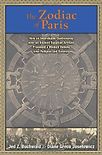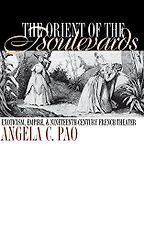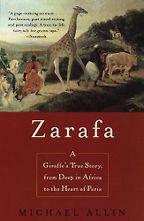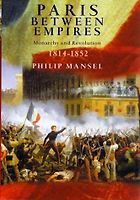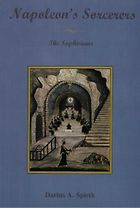All the books you have chosen are part of the research you did for your own book, The Zodiac of Paris. What made you interested in this part of France’s history?
The book began when Jed, my co-author, stumbled into a tiny bookshop near the Luxembourg Palace in Paris and found an antique and expensively bound collection of pamphlets which all had to do with this thing called the Dendera Zodiac. He headed to the Louvre, where he quickly found the zodiac installed in a chamber off the main Egyptian Hall, where it can still be seen today.
The Dendera Zodiac is an ancient bas-relief temple ceiling adorned with mysterious symbols of the stars and planets as well as hieroglyphics. It was first discovered by the French during Napoleon’s campaign in Egypt and was brought to Paris in 1821. The zodiac appeared to depict the night-time sky from a time predating Biblical Creation, and therefore cast doubt on religious truth.
So in our book we set out to tell the story of this incredible archaeological find and its unlikely role in the fierce disputes over science and faith in Napoleonic and Restoration France. While we were unearthing this story we used newspapers, journals, diaries, pamphlets, and other documentary evidence to help us find our way. The five books I have chosen were also extremely helpful and gave a real insight into this fascinating but little known episode in history.
Tell me about your first choice, Paris Between Empires by Philip Mansel.
Historians who like to write about 19th-century French history often focus on the same things: the Revolution of 1789 and the Napoleonic era are at one end of the timeline and the establishment of the Second Republic at the other. People focus on these two periods for obvious reasons, because there is so much politically going on. But what gets missed is the Bourbon Restoration, in between. When we were doing preliminary research for our book, we found there weren’t too many books available to us to put that era in context, but this is one of them.
The Restoration, which begins in 1814, is marked by two interesting things. The first is the union of monarchy and the Catholic Church. Napoleon opened the door to this union by making various deals with the Vatican in the first years of the Consulate. When the Bourbons returned to power, this alliance between Church and state deepened considerably.
The second interesting aspect of this period is its approach to history. The reactionary tenor of the period can be seen in the government’s imposition of an official policy of what was called ‘oubli’, or forgetting, of the past Napoleonic era. All relics of the time, like books and uniforms, had to be burned. Press censorship was extremely oppressive and history was essentially rewritten to minimise the effects of the prior period’s very real and sweeping social and political changes. What was really useful for us was how much detail there was about the era in the book. You get the sense that anyone involved in politics had to be very slippery in order to survive.
Mansel is very good on the period’s political animals, like Joseph Fouché, whose résumé included stints as Napoleon’s minister of police as well as a powerful position under the Bourbons. These intrigants really were a breed apart, exceptionally self-seeking and opportunistic. Power moved from faction to faction, and if you were too closely linked to one faction it could work against you when that faction fell out of favour.
Your next book is The Orient of the Boulevards by Angela C Pao.
One of the most intriguing aspects of our research was tracking down the vaudeville play that was written about the zodiac, Le Zodiaque de Paris (from which we took the title of our book). The play was performed in Paris in September 1822, not long after the zodiac arrived. The play is a mirror of the public perceptions of the zodiac. It dramatised the range of responses to the zodiac’s arrival. And people did respond in various ways, from disbelief that something so bizarre could be anything more than a curio, to a belief that the zodiac was proof that religious authority was bogus. The play was performed at what was called a boulevard theatre.
At this time, as I mentioned, there was a lot of censorship and only a handful of theatres had official status and government support. At the state theatres, you could see the plays by the usual heroes of French drama – Racine, Molière, Corneille. And of course you could go to the opera. But if you wanted something different, edgier, more illicit, the boulevard theatres were the place to go. They were numerous, popular and affordable and gave audiences a lot more variety than the state theatres because they included forms like melodrama and vaudeville. They were also exciting. While the shows were heavily censored like everything else, the crowds were rowdier and the actors and playwrights did play to this aspect. Theatre riots were not uncommon.
Pao’s book looks at the evolving representations of the Orient on the stages of the popular boulevard theatres of Paris from the early 19th century until their destruction during Haussmann’s urban renewal. She shows just how popular things to do with the Orient were at the time. Le Zodiaque de Paris, the vaudeville play about the Dendera Zodiac, can be counted among these plays that put ideas about Egypt on the popular stage.
Before we move on to your next book, can you explain why the French were so taken with all things Egyptian?
There had been a low-grade fever of Egyptomania in Europe for centuries. Many intellectuals, wondering about the origins of Western civilisation, looked to Egypt as an alternative to ancient Greece and Rome. So Napoleon’s Egyptian campaign, an imperial and colonial adventure that he undertook between 1798-1801, resonated with and enlarged upon a pre-existing fascination. His imperial ambitions in Egypt dovetailed with an existing soft spot for ‘all things Egyptian’ in France.
Napoleon’s obsession with Egypt went back a long way as well. He saw himself as a new Alexander, and like Alexander he wanted to conquer Egypt, as he hoped that doing so would secure his place in history as an imperial ruler. While the campaign was a military failure, it was a cultural and intellectual success. After Napoleon returned, he put into motion the publication of The Description of Egypt, a multi-volume, lavishly illustrated study of Egypt which brought together much that was already known about Egypt, as well as introducing a great deal of new scientific, ethnographic, and art-historical material. The work is still considered one of the founding documents of Egyptology, and when it was published, it was a huge success – in part, because it had a ready-made audience. It excited many people who were already inclined to take notice of these things.
Your next book is all about secret societies. This is Napoleon’s Sorcerers by Darius A Spieth.
This is a quirky book. I was surprised at how much material Spieth had managed to dig up about a very obscure subject, a secret society called The Sacred Order of Sophisians, which had connections to Napoleon’s Egyptian campaign as well as the world of the boulevard theatres. During Napoleon’s rule, Freemasonic circles in France invented rituals that allegedly first took place in the temple structures of ancient Egypt. So what Spieth is doing in his book is looking at the cultural environment and intellectual background of one such pseudo-Egyptian secret society.
The Sophisians were founded by a playwright, Cuvelier de Trie, but for a number of years the society’s membership was dominated by veterans of Napoleon’s Egyptian campaign. And in a time where censorship was still going strong it became a safe place for them to talk about what had happened in Egypt, and what was happening, during and after Napoleon’s rise to power, which seemed to betray Republican ideals. This study is based on previously unpublished archival materials relating to the Sophisians, including the group’s so-called Golden Book at the Bibliothèque Nationale in Paris. A richly illuminated manuscript envisioned by Marie-Nicolas Ponce-Camus, a student of Jacques-Louis David, the Golden Book features underground mazes, cave settings, pyramids and temple structures as theatrical settings.
Your fourth book is all about a giraffe – Michael Allin’s Zarafa.
Yes, Zarafa. This book tells the story of a giraffe that was brought to Paris in 1826. It had been captured and shipped down the Nile and across the Mediterranean in a boat which had a hatch on the deck that was made especially for the accommodation of the giraffe. I like this book because it is the story of an object from Egypt which, like the Dendera Zodiac, was transformed immediately upon its arrival in France into a popular sensation, a spectacle.
Allin’s book is not an academic analysis of French Egyptomania. Although I think Allin is sensitive to the issues of cultural ‘otherness’ that are inevitably involved in any study of Western encounters with Egypt, his book is written for a lay audience and the focus is on telling a story. It gave us a model for writing about the Dendera Zodiac, a similarly spectacular object, that was an alternative to academic analyses of Western ‘Orientalism’.
Another thing that is interesting about the giraffe is that it was sent over as a gift from the viceroy of Egypt, Muhammad Ali, whom we write about quite a bit ourselves in our book. Ali was an ambiguous figure, both at home in Egypt as well as in the eyes of his European interlocutors. In this instance, the gift of the giraffe was intended to distract Charles X while Egyptian forces invaded Greece. As political ploy, it didn’t work. But as ambassador from an exotic land, this odd animal captivated the French people for almost two decades, as she lived out her life as part of the royal menagerie.
Your final book is quite some tome. This is Martin Rudwick’s Bursting the Limits of Time.
Yes, it is pretty big. Rudwick is an historian of tremendous range and learning and it is all on display in this book. It is a history of the establishment of what he calls ‘geohistory,’ which is a mode of thought, a way of thinking about the earth as something with a history. This mode of thought grew up in the late 18th and early 19th century in Europe. Specifically, Rudwick traces the early history of what we now think of as separate sciences, geology, palaeontology, and the study of so-called ‘deep time’. He sees all these strands as unified in a coherent body of knowledge concerned with the story of the history of the earth, conceived as something that actually does undergo historical change.
For us, nowadays, this is not a new idea. We are able to think in evolutionary terms. But at the time Rudwick is studying, the idea of ‘evolution’ wasn’t as precisely articulated, and the very notion that the natural world might undergo that sort of change was truly revolutionary. The controversies over the Dendera Zodiac were part of this shift in our way of thinking about historical time, the age of the earth, and the earth itself as a specifically historical object. For us the book suggested a way of contextualising the debates about the Dendera Zodiac. They occurred within a context where naturalists, palaeontologists and astronomers were all struggling with the same issue, how to think about the natural world as something that changed over time.
August 20, 2010. Updated: September 21, 2022
Five Books aims to keep its book recommendations and interviews up to date. If you are the interviewee and would like to update your choice of books (or even just what you say about them) please email us at [email protected]
Five Books interviews are expensive to produce. If you've enjoyed this interview, please support us by donating a small amount.

